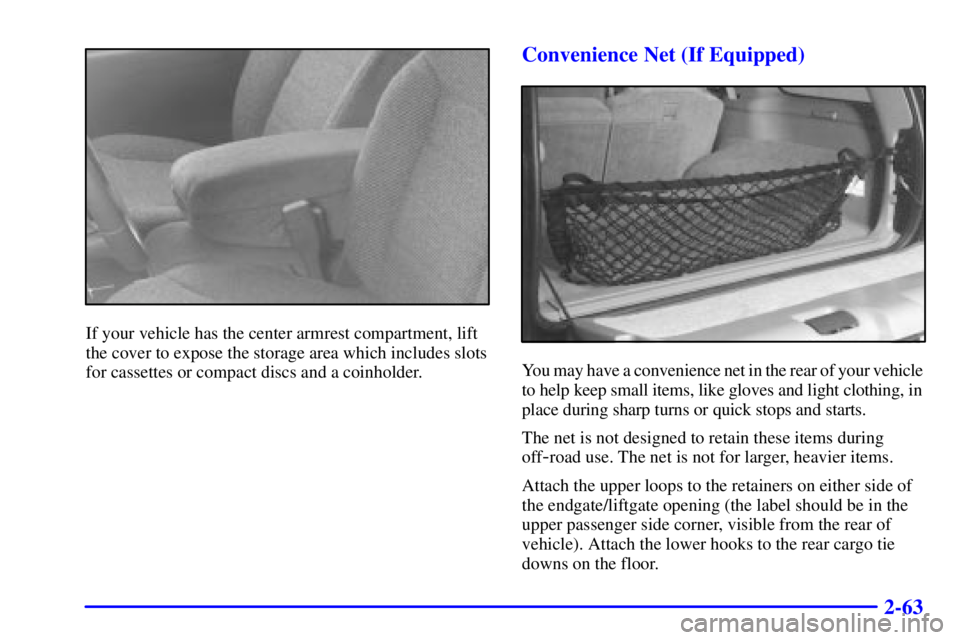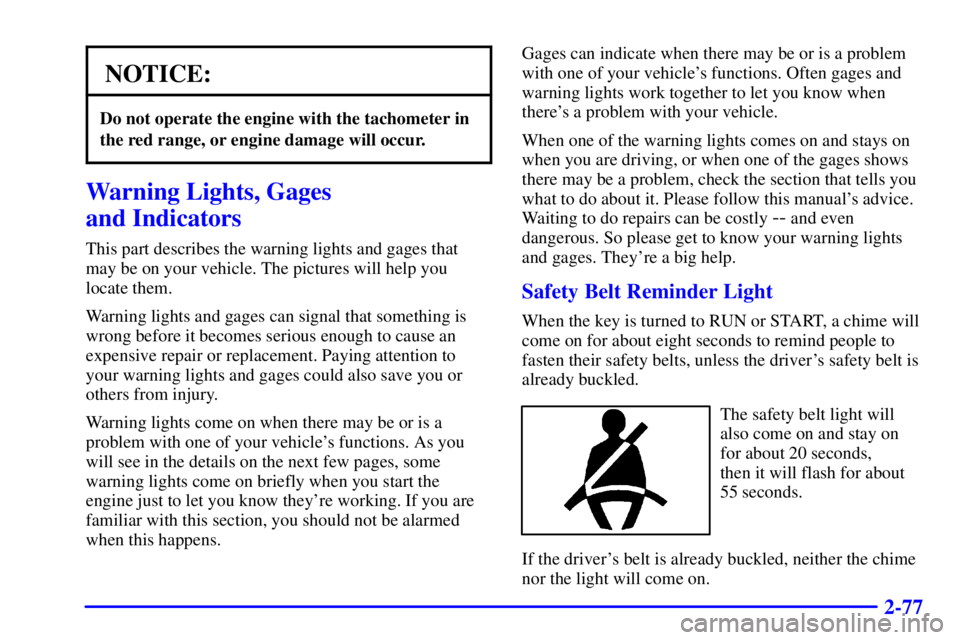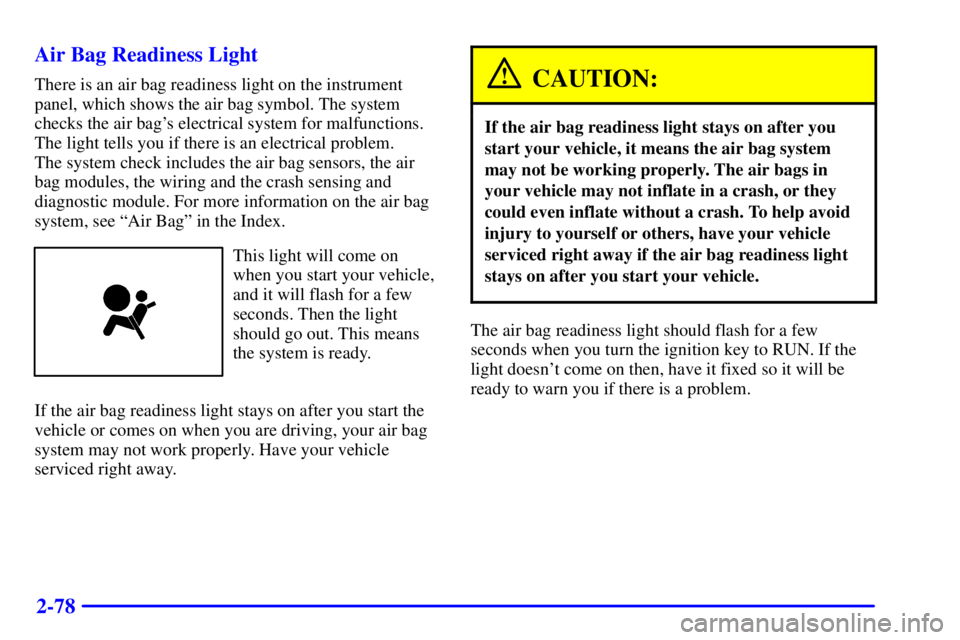light GMC JIMMY 2000 Owner's Guide
[x] Cancel search | Manufacturer: GMC, Model Year: 2000, Model line: JIMMY, Model: GMC JIMMY 2000Pages: 430, PDF Size: 2.9 MB
Page 122 of 430

2-54 Electrochromic Day/Night Inside Rearview
Mirror (If Equipped)
This mirror automatically changes to reduce glare from
headlamps behind you. A photocell on the back of the
mirror senses when it is becoming dark outside. Another
photocell built into the mirror surface senses when
headlamps are behind you.
At night, when the glare is too high, the mirror will
gradually darken to reduce glare (this change may take a
few seconds). The mirror will return to its clear daytime
state when the glare is reduced. The mirror will also
return to its clear daytime state when the vehicle is put
into REVERSE (R).Press the AUTO button at the base of the mirror to turn
on the automatic feature. The button has an indicator
light to show it is on. Press the OFF button to turn the
automatic feature off.
Time Delay
The automatic mirror has a time delay feature which
prevents unnecessary switching from the night back to
the day position. This delay prevents rapid changing of
the mirror as you drive under lights and through traffic.
Page 126 of 430

2-58
The pegs inside the
compartment door are used
to make sure the button on
the compartment door will
contact the control button
on the garage door opener.
Add one peg at a time until the garage door opener
operates with the compartment door closed when you
press the button.Now, with the compartment
door closed, press the
button again to make sure
the garage door opener
operates properly.
With the garage door opener positioned properly and the
right number of pegs in place, you should only have
to press the button slightly to operate the opener.
Adjust the position of the garage door opener and
add or remove pegs, as needed, until the opener
operates properly.
Page 131 of 430

2-63
If your vehicle has the center armrest compartment, lift
the cover to expose the storage area which includes slots
for cassettes or compact discs and a coinholder.
Convenience Net (If Equipped)
You may have a convenience net in the rear of your vehicle
to help keep small items, like gloves and light clothing, in
place during sharp turns or quick stops and starts.
The net is not designed to retain these items during
off
-road use. The net is not for larger, heavier items.
Attach the upper loops to the retainers on either side of
the endgate/liftgate opening (the label should be in the
upper passenger side corner, visible from the rear of
vehicle). Attach the lower hooks to the rear cargo tie
downs on the floor.
Page 134 of 430

2-66
NOTICE:
Loading cargo that weighs more than 200 lbs.
(91 kg) on the luggage carrier may damage your
vehicle. When you carry large things, never let
them hang over the rear or the sides of your
vehicle. When loading cargo on the roof panel,
be sure it rests on the slats and does not scratch
or damage the vehicle.
Put the cargo against the side rails and fasten it
securely to the luggage carrier. Put the main
weight as far forward as you can and move the
rear crossrail forward as far as possible to keep
the load from shifting.
Don't exceed the maximum vehicle capacity when
loading your vehicle. For more information on vehicle
capacity and loading, see ªLoading Your Vehicleº
in the Index.
To prevent damage or loss of cargo as you're driving,
check now and then to make sure the luggage carrier and
cargo are still securely fastened.
Ashtrays and Cigarette Lighter
Pull the front ashtray door down to open it.
NOTICE:
Don't put papers and other things that burn
into your ashtray. If you do, cigarettes or other
smoking materials could set them on fire,
causing damage.
To remove the front ashtray, pull the bin upward.
To use the lighter, press it in all the way, and let go.
When it's ready, it will pop back by itself.
NOTICE:
Don't hold a cigarette lighter in with your hand
while it is heating. If you do, it won't be able to
back away from the heating element when it's
ready. That can make it overload, damaging the
lighter and the heating element.
Page 138 of 430

2-70 Programming the Transmitter
Do not use the HomeLink Transmitter with any garage
door opener that does not have the ªstop and reverseº
feature. This includes any garage door opener model
manufactured before April 1, 1982.
Be sure that people and objects are clear of the garage
door you are programming.
Your vehicle's engine should be turned off while
programming the transmitter. Follow these steps to
program up to three channels:
1. If you have previously programmed a transmitter
channel, proceed to Step 2. Otherwise, hold down
the two outside buttons on the HomeLink
Transmitter until the indicator light begins to flash
rapidly (after 20 seconds). Then release the buttons.
This procedure initializes the memory and erases any
previous settings for all three channels.
2. Decide which one of the three channels you want to
program. Hold the end of the hand
-held transmitter
about 2 to 5 inches (5 to 13 cm) away from the
surface of the HomeLink Transmitter so that you can
still see the indicator light.3. Using both hands, press the hand
-held transmitter
button and the desired button on the HomeLink
Transmitter. Continue to press both buttons
through Step 4.
4. Hold down both buttons until you see the red light
on the HomeLink Transmitter flash rapidly.
The rapid flashing indicates that the HomeLink
Transmitter has been programmed. Release both
buttons once the light starts to flash rapidly.
If you have trouble programming the HomeLink
Transmitter, make sure that you have followed the
directions exactly as described and that the battery in the
hand
-held transmitter is not dead. If you still cannot
program it, rotate the hand
-held transmitter end over end
and try again. The HomeLink Transmitter may not work
with older garage door openers that do not meet current
Federal Consumer Safety Standards. If you cannot
program the transmitter after repeated attempts, refer to
ªTraining a Garage Door Opener with Rolling Codesº
later in this section or contact the manufacturer of the
unit at 1
-800-355-3515.
Be sure to keep the original hand
-held transmitter
in case you need to erase and reprogram the
HomeLink Transmitter.
Page 139 of 430

2-71
Note to Canadian Owners: During programming,
the hand
-held transmitter may automatically stop
transmitting after one or two seconds. In this case, you
should press and re
-press the button on the hand-held
transmitter every two seconds without ever releasing the
button on the HomeLink Transmitter. Release both
buttons when the indicator light on the HomeLink
Transmitter begins to flash rapidly.
Operating the Transmitter
Press and hold the appropriate button on the HomeLink
Transmitter. The indicator light comes on while the
signal is being transmitted.
If the hand
-held transmitter appears to program the
HomeLink Transmitter but does not open your garage
door, and if the garage door opener was manufactured
after 1996, the garage door opener may have a ªrolling
codeº system. A rolling code system changes the code
of the garage door opener every time you open or close
the garage door.
To determine if you have this system, press the button on the
HomeLink Transmitter that you have programmed already.
If the indicator light flashes rapidly for one to two seconds,
then turns solid, the garage door opener has a rolling code
system. In a rolling code system, the garage door motor head
unit must be trained to the HomeLink Transmitter.
Training a Garage Door Opener with a
ªRolling Codeº Feature (If Equipped)
If you have not previously programmed the hand-held
transmitter to the HomeLink Transmitter, see
ªProgramming the Transmitterº listed previously.
If you have completed this programming already, you
now need to train the garage door opener motor head
unit to recognize the HomeLink Transmitter. Refer to
your garage door opener owner's manual for the proper
transmitter training procedure for your garage door
opener brand.
1. Find the training button on the garage door opener
motor head unit. The exact location and color will
vary by garage door opener brand. If you have
difficulty finding the training button, refer to your
garage door opener owner's manual.
Page 140 of 430

2-72
2. Press the training button on the garage door opener
motor head unit. An indicator light will begin to
flash when the motor head unit enters the
training mode.
Following this step, you have 30 seconds to
start Step 3.
3. Return to the HomeLink Transmitter in your vehicle
and firmly press and release the HomeLink
Transmitter button you have already programmed for
two to three seconds. Press and release the button
again (you may need to do this step up to three
times) to make sure that the HomeLink Transmitter
has been trained to the garage door opener motor
head unit. Check that the training was successful.
The motor head unit indicator light should no longer
be flashing.
The garage door opener should now recognize the
HomeLink Transmitter. You may either use the
HomeLink Transmitter or the hand
-held transmitter to
open the garage door.If after following these instructions, you still have
problems training the garage door opener, call the
manufacturer of the unit at 1
-800-355-3515.
Erasing Channels
To erase all three programmed channels, hold down the
two outside buttons until the indicator light begins to
flash (after 20 seconds). Release both buttons.
Accessories
Accessories for the HomeLink Transmitter are available
from the manufacturer of the unit. If you would like
additional information, please call 1
-800-355-3515.
Page 145 of 430

2-77
NOTICE:
Do not operate the engine with the tachometer in
the red range, or engine damage will occur.
Warning Lights, Gages
and Indicators
This part describes the warning lights and gages that
may be on your vehicle. The pictures will help you
locate them.
Warning lights and gages can signal that something is
wrong before it becomes serious enough to cause an
expensive repair or replacement. Paying attention to
your warning lights and gages could also save you or
others from injury.
Warning lights come on when there may be or is a
problem with one of your vehicle's functions. As you
will see in the details on the next few pages, some
warning lights come on briefly when you start the
engine just to let you know they're working. If you are
familiar with this section, you should not be alarmed
when this happens.Gages can indicate when there may be or is a problem
with one of your vehicle's functions. Often gages and
warning lights work together to let you know when
there's a problem with your vehicle.
When one of the warning lights comes on and stays on
when you are driving, or when one of the gages shows
there may be a problem, check the section that tells you
what to do about it. Please follow this manual's advice.
Waiting to do repairs can be costly
-- and even
dangerous. So please get to know your warning lights
and gages. They're a big help.
Safety Belt Reminder Light
When the key is turned to RUN or START, a chime will
come on for about eight seconds to remind people to
fasten their safety belts, unless the driver's safety belt is
already buckled.
The safety belt light will
also come on and stay on
for about 20 seconds,
then it will flash for about
55 seconds.
If the driver's belt is already buckled, neither the chime
nor the light will come on.
Page 146 of 430

2-78 Air Bag Readiness Light
There is an air bag readiness light on the instrument
panel, which shows the air bag symbol. The system
checks the air bag's electrical system for malfunctions.
The light tells you if there is an electrical problem.
The system check includes the air bag sensors, the air
bag modules, the wiring and the crash sensing and
diagnostic module. For more information on the air bag
system, see ªAir Bagº in the Index.
This light will come on
when you start your vehicle,
and it will flash for a few
seconds. Then the light
should go out. This means
the system is ready.
If the air bag readiness light stays on after you start the
vehicle or comes on when you are driving, your air bag
system may not work properly. Have your vehicle
serviced right away.
CAUTION:
If the air bag readiness light stays on after you
start your vehicle, it means the air bag system
may not be working properly. The air bags in
your vehicle may not inflate in a crash, or they
could even inflate without a crash. To help avoid
injury to yourself or others, have your vehicle
serviced right away if the air bag readiness light
stays on after you start your vehicle.
The air bag readiness light should flash for a few
seconds when you turn the ignition key to RUN. If the
light doesn't come on then, have it fixed so it will be
ready to warn you if there is a problem.
Page 147 of 430

2-79 Charging System Indicator Light
The charging system light
will come on briefly when
you turn on the ignition, but
the engine is not running,
as a check to show you it
is working.
It should go out once the engine is running. If it stays
on, or comes on while you are driving, you may have a
problem with the charging system. It could indicate that
you have problems with a generator drive belt, or
another electrical problem. Have it checked right away.
Driving while this light is on could drain your battery.
If you must drive a short distance with the light on, be
certain to turn off all your accessories, such as the radio
and air conditioner.
Voltmeter Gage
When your engine is not
running, but the ignition is
on (in RUN), this gage
shows your battery's state
of charge in DC volts.
When the engine is running, the gage shows the
condition of the charging system. Readings between the
low and high warning zones indicate the normal
operating range.
Readings in the low warning zone may occur when a
large number of electrical accessories are operating in
the vehicle and the engine is left at an idle for an
extended period. This condition is normal since the
charging system is not able to provide full power at
engine idle. As engine speeds are increased, this
condition should correct itself as higher engine speeds
allow the charging system to create maximum power.